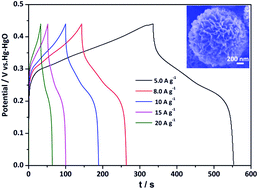Hierarchical porous NiCo2O4/CeO2 hybrid materials for high performance supercapacitors†
Abstract
In this work, hierarchical porous NiCo2O4/CeO2 hybrid materials are successfully designed via a facile solvothermal method and subsequent heat treatment, and possess a large specific surface area (113.02 m2 g−1). The hierarchical porous structure and large specific surface area can effectively increase the contact area between the electrode and electrolyte, and also provide rich channels for ion and electron transport. Therefore, when explored as an electrode material in a supercapacitor with KOH and K4[Fe(CN)6] electrolytes, the NiCo2O4/CeO2 hybrid materials show a high specific capacitance of 2659.1 F g−1 at 5.0 A g−1 and excellent cycling performances with 99.6% initial capacity retention after 5000 continuous charge–discharge cycles. Moreover, an asymmetric supercapacitor device was assembled by employing NiCo2O4/CeO2 and activated carbon as a positive and negative electrode, respectively. The device delivers a high energy density of 43.3 W h kg−1 at a power density of 1550 W kg−1. Impressively, the energy density can still reach up to 36.9 W h kg−1 at 4650 W kg−1. These remarkable electrochemical performances demonstrate that the hierarchical porous NiCo2O4/CeO2 hybrid materials are a promising candidate for supercapacitors.



 Please wait while we load your content...
Please wait while we load your content...